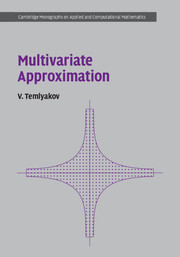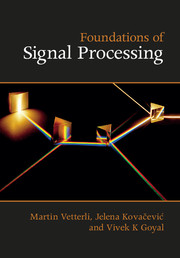Refine search
Actions for selected content:
1206 results in Computer Graphics, Image Processing and Robotics
Chapter 7 - Entropy
-
- Book:
- Multivariate Approximation
- Published online:
- 06 July 2018
- Print publication:
- 19 July 2018, pp 321-386
-
- Chapter
- Export citation
Appendix - Classical Inequalities
-
- Book:
- Multivariate Approximation
- Published online:
- 06 July 2018
- Print publication:
- 19 July 2018, pp 500-519
-
- Chapter
- Export citation
Frontmatter
-
- Book:
- Multivariate Approximation
- Published online:
- 06 July 2018
- Print publication:
- 19 July 2018, pp i-iv
-
- Chapter
- Export citation

Multivariate Approximation
-
- Published online:
- 06 July 2018
- Print publication:
- 19 July 2018

Foundations of Signal Processing
-
- Published online:
- 28 May 2018
- Print publication:
- 04 September 2014
-
- Textbook
- Export citation
5 - Evolution of CDMA Systems
-
- Book:
- Media and Radio Signal Processing for Mobile Communications
- Published online:
- 23 March 2018
- Print publication:
- 19 April 2018, pp 150-194
-
- Chapter
- Export citation
Contents
-
- Book:
- Media and Radio Signal Processing for Mobile Communications
- Published online:
- 23 March 2018
- Print publication:
- 19 April 2018, pp vii-xii
-
- Chapter
- Export citation
8 - Signal Processing in SC-FDMA/OFDMA Systems
-
- Book:
- Media and Radio Signal Processing for Mobile Communications
- Published online:
- 23 March 2018
- Print publication:
- 19 April 2018, pp 292-377
-
- Chapter
- Export citation
7 - Evolution of W-CDMA Systems
-
- Book:
- Media and Radio Signal Processing for Mobile Communications
- Published online:
- 23 March 2018
- Print publication:
- 19 April 2018, pp 272-291
-
- Chapter
- Export citation
Dedication
-
- Book:
- Media and Radio Signal Processing for Mobile Communications
- Published online:
- 23 March 2018
- Print publication:
- 19 April 2018, pp v-vi
-
- Chapter
- Export citation
3 - Evolution of TDMA Systems
-
- Book:
- Media and Radio Signal Processing for Mobile Communications
- Published online:
- 23 March 2018
- Print publication:
- 19 April 2018, pp 64-113
-
- Chapter
- Export citation
4 - Signal Processing in CDMA Systems
-
- Book:
- Media and Radio Signal Processing for Mobile Communications
- Published online:
- 23 March 2018
- Print publication:
- 19 April 2018, pp 114-149
-
- Chapter
- Export citation
Acknowledgements
-
- Book:
- Media and Radio Signal Processing for Mobile Communications
- Published online:
- 23 March 2018
- Print publication:
- 19 April 2018, pp xv-xv
-
- Chapter
- Export citation
9 - Evolution of SC-FDMA/OFDMA Systems
-
- Book:
- Media and Radio Signal Processing for Mobile Communications
- Published online:
- 23 March 2018
- Print publication:
- 19 April 2018, pp 378-450
-
- Chapter
- Export citation
1 - Introduction
-
- Book:
- Media and Radio Signal Processing for Mobile Communications
- Published online:
- 23 March 2018
- Print publication:
- 19 April 2018, pp 1-17
-
- Chapter
- Export citation
Index
-
- Book:
- Media and Radio Signal Processing for Mobile Communications
- Published online:
- 23 March 2018
- Print publication:
- 19 April 2018, pp 465-470
-
- Chapter
- Export citation
2 - Signal Processing in TDMA Systems
-
- Book:
- Media and Radio Signal Processing for Mobile Communications
- Published online:
- 23 March 2018
- Print publication:
- 19 April 2018, pp 18-63
-
- Chapter
- Export citation
Preface
-
- Book:
- Media and Radio Signal Processing for Mobile Communications
- Published online:
- 23 March 2018
- Print publication:
- 19 April 2018, pp xiii-xiv
-
- Chapter
- Export citation
10 - Signal Processing in 5G Systems
-
- Book:
- Media and Radio Signal Processing for Mobile Communications
- Published online:
- 23 March 2018
- Print publication:
- 19 April 2018, pp 451-464
-
- Chapter
- Export citation
Frontmatter
-
- Book:
- Media and Radio Signal Processing for Mobile Communications
- Published online:
- 23 March 2018
- Print publication:
- 19 April 2018, pp i-iv
-
- Chapter
- Export citation
